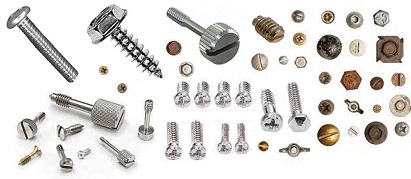Hardware Screws

The screw is a fastener that uses a helical groove, called a thread, cut into the outside of a cylindrical rod. It mates with a reverse helical groove cut into the inside of a cylindrical hole, either in a solid body or a small object called a nut. Turning the screw into the mating threaded hole advances the screw into the mating surface. If the screw is first passed through an object, turning the screw until the object and the mounting surface are joined mounts the object to the surface.
Screws play a crucial role in the field of electronics, serving various purposes in the design, assembly, and maintenance of electronic devices.
Machine Screws
The machine screw is a smaller diameter bolt and comes in several different head styles. These screws have flat ends and use a nut to complete the fastening. The machine screw is used in mechanical construction and product assembly such as machinery, appliances and electronic panels. Machine screw head styles include round, pan, flat and flat undercut. Drive types are phillips, slotted and phillips/slot combo. Each screw style allows the screw to be flush against the surface when fastened.
Screws are manufactured with a variety of head shapes. Each head shape provides specific advantages. For example, a flathead screw is generally countersunk so that the head is completely below the surface into which the screw is driven. This keeps the surface free of projections. The most common screw head types used in electronics assembly are used:
- Fastening Components:
- Motherboards and Circuit Boards: Screws are used to secure motherboards and circuit boards to the chassis or other support structures within electronic devices. This ensures stability and proper alignment of components.
- Connectors and Modules: Screws are often used to secure connectors, modules, and other components to the circuit board, providing mechanical stability and preventing accidental disconnection.
- Enclosure Assembly:
- Chassis and Cases: Electronic devices are typically housed in enclosures or cases. Screws are used to fasten these enclosures, securing the internal components and protecting them from external elements.
- Access Panels: Screws are commonly used to attach access panels or covers, allowing easy access to internal components for maintenance or upgrades.
- Heat Sink Attachment:
- Cooling Systems: Heat sinks are crucial for dissipating heat generated by electronic components. Screws are used to attach heat sinks to the components, ensuring proper thermal management.
- Mounting Components:
- Fans and Cooling Systems: Screws are used to mount fans for cooling purposes. Fans are essential in preventing electronic components from overheating.
- Displays and Screens: In devices with displays or screens, screws are used to secure these components in place within the device structure.
- Modular Design and Repair:
- Modular Components: Screws facilitate the assembly of modular components, allowing for easier replacement or repair of specific parts without affecting the entire device.
- Maintenance and Upgrades: Devices that are designed for user maintenance or upgrades often use screws to secure panels or modules that can be easily removed by the end user.
- Standardization:
- Thread Types: Standardized screw threads are commonly used in electronics to ensure compatibility and ease of assembly. Common thread types include metric and imperial threads.
- Anti-Vibration Measures:
- Isolation: In certain applications, screws with special features may be used to reduce vibrations and prevent damage to sensitive electronic components.
- Material Considerations:
- Corrosion Resistance: Depending on the environment in which the electronic device operates, screws made from corrosion-resistant materials may be used to prevent rust or degradation over time.
Small Screw Style Options
- Captive Screws
- Hex Jack Screws
- Shoulder Screws: Socket Head, Slotted Head
- Socket Head Captive Screws
- Thumbscrews: Washer Face Screw, Push Type Screw, Plain Screw
In summary, screws in electronics serve a diverse range of functions, from securing circuit boards and components to facilitating maintenance and upgrades. The choice of screws and their proper installation is critical to ensuring the reliability and longevity of electronic devices.
